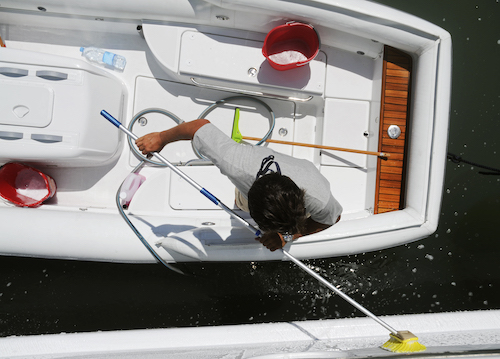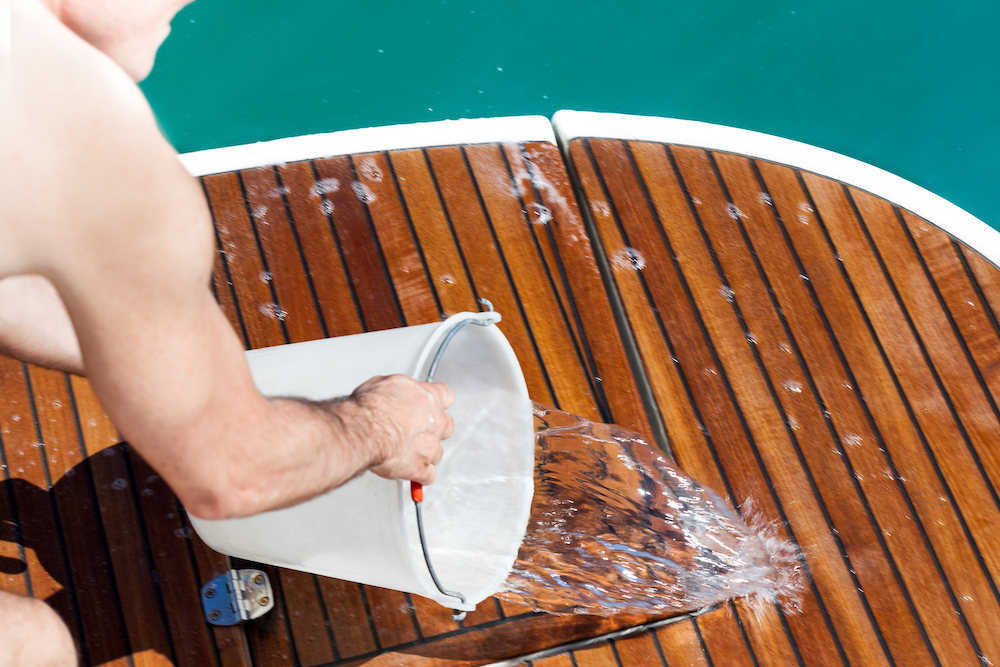Keeping your boat clean and looking good isn’t just a matter of pure vanity; it’s also an essential part of basic boat maintenance. It extends the useful lifespan of materials exposed to the environment and greatly improves functionality. Plus, if you keep it in top shape, you can sell your boat for a profit when the time comes to upgrade.
Essentially, knowing how to clean a boat is imperative for any boat owner! And effective boat cleaning involves focusing on these specific areas:
- Interior surfaces (carpet, fiberglass, vinyl, cushions, head)
- Exterior surfaces (hull, gel-coat, canvas)
- Engine
- Teak
Ready to get scrubbing? Let’s look at how to clean your boat's different pieces and parts inside and out.

How to Clean a Boat Interior
Whether you have a big cabin cruiser or a bowrider with a head compartment, each part of the boat’s interior has its own needs. The items to consider include:
- Marine Carpet
- Non-slip Fiberglass
- Vinyl
- Cushions
- Heads
And that’s just the interior! Keep scrolling for our expert-backed boating cleaning tips for the entire vessel.
The Best Way to Clean a Boat Carpet
The carpet on your boat is notorious for getting pretty dirty. People are constantly walking on it with wet feet; it’s continually filled with moisture, and spills can happen anytime. So, knowing the best way to clean a boat carpet is essential!
To get started, you should know that marine carpet is the flooring found in cabins and may also be inside the cockpits or head compartments. Some boats, like bass boats, are commonly carpeted inside from bow to stern. Luckily, cleaning them is basically the same, no matter what type of vessel!
Start by taking out everything that is in the way. Then, we recommend using a vacuum to remove any loose dirt. And then give it an old-fashioned scrub-down with a stiff-bristle brush, soap, and water.
As for removing the dirty water, trailer boats can be parked on an incline so most of the water drains away via gravity. But on larger ships and inside cabins, you may need to suck up the remaining water with a wet vac. Lastly, finish up by speed drying by running the air-conditioning and/or fans!
Cleaning Boat Fiberglass: Tackle Oxidation and Stains
You'll find non-slip fiberglass with molded-in non-skid both inside and outside various boat types. However, you can't treat it like other fiberglass parts! Applying wax would make it slippery, defeating the purpose of a non-skid surface. So, when considering the best way to clean a boat carpet versus cleaning boat fiberglass, remember these differences.
As you might expect, this process will begin with a hard scrub using a stiff bristle brush, soap, and water. You can tackle tough stains with bleach cleaner, such as Soft Scrub. (But use it sparingly and thoroughly rinse it away because bleach is harsh on fiberglass surfaces.)
Then, a specialized non-skid treatment, such as Star Brite Non-Skid Deck Wax or Woody Wax, can be applied. Technically, these products are not "wax" in the traditional sense but rather polymer-based protectants that help shine and protect the non-skid without making it slippery. (Think of them as suntan lotion for your boat's non-skid.)
Read Next: Basic Boat Maintenance Guide
Vinyl Boat Cleaning Tips
You'll find plenty of vinyl on all kinds of boats, especially the ones made for cruising or watersports. Modern marine vinyl is factory-treated with anti-microbial, making it your top choice for keeping mold and mildew at bay in the long run. So, avoid those strong chemical cleaners that can take them off.
Instead, make sure to keep your vinyls nice and clean! Give them a gentle wash with soapy water and a soft cloth each time you use the boat. And for those stubborn stains, grab a marine vinyl cleaner and give it a good scrub. After that, rinse it well and finish with a vinyl protectant for extra shine!

Boat Cushions
Over time, interior cushions can get a bit musty, stained by spills, and even have some mildew creeping in. Start by removing the covers and washing them in cold water. Most cushion covers that aren't vinyl can go in the washing machine, but be careful! Avoid hot water and the dryer, or you might end up with some seriously shrunken covers.
To tackle the foam, start by sprinkling baking soda on each side of the cushion. Let it sit for a few hours, then just shake it off! Next, give the foam a light spray with a mix of half vinegar and half water.
Then, set the cushion in a breezy spot for a few days until the smell of vinegar fades. Then, give them a good spray with the hose, wring out the water, and respray them. (It often takes a few soaking rounds to remove all the dirt.) Once you've given them a good squeeze, just let them dry out in the air before putting the covers back on.
Washing the Heads (Toilets)
Cleaning marine heads is similar to tidying up the toilets at home, but when it comes to the lines where scale and calcium build up, that's a different ball game. Fortunately, the solution is easy! Once a month, simply run a few cups of white vinegar through the lines.
Cleaning Boat Hull and Exteriors
Okay – the inside’s all set. Now, let’s look at cleaning the boat hull and exterior. The items to address include:
- Hull and Gel-coat Surfaces
- Hull bottoms
- Canvas and Clear Canvas (Isinglass)
- Engines
- Teak
Hull and Gel-Coat Surfaces
Hullsides and other smooth gel-coated surfaces need excellent care to keep them shiny and prevent oxidation. Every spring, it all begins with two layers of paste wax as a base coat.
Additionally, make your boat sparkle once a month by putting on some liquid carnauba wax. And after each use, give your boat a thorough wash with a soap with some liquid wax, often called “wash ‘n wax” soap.
When your boat is on a trailer or lift, take care of the hull bottom just like you would with any other gel-coated surfaces. And if your boat is in a wet slip, chances are you've had the bottom painted with antifouling paint.
Boat Canvas
The boat canvas should be cleaned monthly to prevent staining and dirt buildup. Simply hose it down, scrub it with a soft-bristle brush and a mild soap like Woolit, and rinse. (A deeper clean may be needed every few years.)
If it’s small enough, the canvas can be gently machine-washed with warm (under 120 degrees) water, soap, and two cups of baking soda. If this doesn't do the trick or the canvas is too big for the washing machine, scrub it by hand.
Some manufacturers recommend a baking soda/soap mix or a cup of bleach and a quarter-cup of soap in a gallon of water. But before doing this, consult your canvas manufacturer.
Clear Canvas (Isinglass)
When it comes to clear canvas, remember that there are several different types, including polycarbonate, acrylic, and polyvinyl. Cleaning all of these begins with a gentle wash-down with soapy water and a non-abrasive sponge or microfiber cloth every time the boat returns to the dock.
Follow the wash-up by wiping the curtains with a squeegee or chamois to remove water droplets and prevent them from drying and leaving behind water spots. However, each manufacturer recommends its own specific polishes and protectants after that stage. Read Enclosure Disclosures to learn more about caring for canvas, clear canvas boat curtains, and the ins and outs of the different types.
Cleaning Boat Engines
Boat engines should be cleaned regularly, inside and out, whether you have an inboard or outboard engine. For outboard engines, begin by giving the cowl and exterior a solid coat of wax. And after each use, wash them down with some soap and water.
These surfaces are very similar to automotive finishes, so treat them just as you treat your car. Stick to microfiber cloths or wash mitts, and avoid using an abrasive bristle brush on the outboard cowl.
What about under the cowl or the engine itself in the case of an inboard? Make sure to clean off any dirt and grime that builds up regularly. But remember that some cleaners and chemicals can harm electrical wires and parts. Besides a quick wipe, it’s generally a good idea to let a professional handle engine cleaning.
Boat Cleaning Tips for the Teak
Simple scrub-downs with soapy water are the best way to clean teak regularly, but this will only get you by for so long. Your teak might start to darken and look uneven, depending on your location, air quality, and UV levels.
At this point, you’ll probably need to use an acid-based teak cleaner. There are easy one-part cleaners and more powerful two-part options to choose from. In both situations, it's important to stick closely to the manufacturer's instructions.
One important note: remove the teak from the boat before using these cleaners. The acids in these cleaners can harm gel coat, paint, and metals. If you don’t completely take the teak off the boat, using these cleaners is challenging without getting some in the surrounding areas.
Don’t Forget These Essential Boat Cleaning Tips
Remember, people, a clean ship is a happy ship. So, whether cleaning boat fiberglass, washing down cushions, or cleaning boat hull, it all must be done! And now that you know how to clean a boat, your pride and joy should be grinning from gunwale to gunwale.
You Might Also Like:
- First Time Boat Owners: How to Get Started
- Spring Start-Up Checklist
- Boat Repair: Choosing a Marine Mechanic
- Boat Storage: What Are My Options?
- How to Winterize Your Boat


